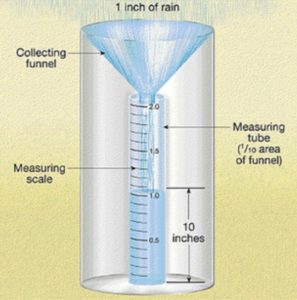How to Choose the Right Rain Gauge for Reliable Precipitation Tracking
How to Choose the Right Rain Gauge for Reliable Precipitation Tracking
Blog Article
Revealing the Scientific Research Behind Rain Determines: How These Instruments Play a Critical Function in Environment Study and Environmental Tracking
Rainfall evaluates, apparently simple gadgets, hold an extensive relevance in the world of climate research and environmental surveillance. These simple tools quietly gather among nature's most important components-- rainfall. Yet, behind their plain exterior exists a complex scientific research that is essential for recognizing the characteristics of our environment. As we peel off back the layers of this scientific veil surrounding rainfall gauges, we reveal a world where precision, data accuracy, and precise observation assemble to reveal a deeper understanding of our transforming climate and its influence on the earth.
Value of Rain Gauges
Rainfall assesses play a crucial duty in tracking and measuring precipitation degrees, offering vital data for environment research study and analysis. These tools are essential in quantifying the quantity of rains that occurs in a details area over a certain duration. By gathering and measuring rain, rain determines offer valuable understandings into the circulation and intensity of rainfall, aiding meteorologists, hydrologists, and climatologists in recognizing weather condition patterns and trends.
Furthermore, long-lasting information accumulated from rainfall determines aids in analyzing climate change impacts and patterns, contributing considerably to scientific research and decision-making processes. In essence, rain gauges serve as important tools in the field of meteorology and environmental science, playing a crucial role in advancing our understanding of weather condition and climate dynamics.
Types of Rainfall Scales
Performance and Operation
In the realm of climate study and atmospheric research studies, the efficiency of rain determines lies in their complex performance and accurate operational devices. Rain evaluates are designed to properly determine the amount of rainfall that tips over a particular area throughout a set duration. These gadgets generally consist of a channel that collects rain and channels it right into a gauging tube. The gauging tube is noted with calibrated dimensions that enable the precise metrology of rainfall.
The capability of rainfall gauges is based upon the concept of gauging and collecting rainwater in a standardized way. This collected information is important for understanding regional climate patterns, tracking long-term environment fads, and evaluating ecological impacts. To guarantee exact dimensions, rain assesses demand to be strategically put in open locations away from obstructions such as structures or trees that can hinder the collection procedure.
The functional aspect of rain determines includes regular maintenance to stop particles buildup, calibration checks to keep measurement precision, and information recording for analysis (rain gauge). Overall, the capability and operation of rain gauges are important for gathering trustworthy rainfall information essential to environment study and ecological surveillance
Role in Environment Research
Given the vital value of precise precipitation dimensions in comprehending weather condition patterns and ecological impacts, the role of rainfall gauges in climate research study is crucial. Rainfall assesses give essential data for environment study by evaluating the amount of precipitation that drops over a details location during a given duration. This information is critical for monitoring long-lasting fads in precipitation patterns, examining the effect of climate change on rainfall distribution, and boosting environment designs.

Environment scientists make use of information gathered from rainfall evaluates to analyze variants in rainfall degrees, determine local climate fads, and assess the performance of water resource monitoring strategies. By contrasting historic rainfall information with existing dimensions, scientists can identify shifts in precipitation patterns, such as changes in the frequency or strength of rains view it now events. This details is important for comprehending how environment change is influencing rainfall characteristics and can assist policymakers make educated choices concerning adjustment and reduction approaches.
Applications in Ecological Monitoring

In flooding forecasting, rain scale information assists to track rains intensity and distribution, permitting authorities to release prompt cautions and take necessary procedures to mitigate flooding dangers (rain gauge). Drought surveillance depends on rain gauge data to analyze wetness levels in the dirt and track precipitation deficits, assisting in the identification of drought-prone areas and the execution of drought action strategies
Additionally, rain gauge information plays a vital function in water source monitoring by supplying details on water availability and usage patterns. Furthermore, in farming, rainfall gauge information aids farmers in optimizing irrigation routines, plant choice, and overall farm administration methods based on neighborhood precipitation patterns.
Verdict
In conclusion, rainfall assesses are important devices for gauging precipitation, giving beneficial data for climate research and ecological surveillance. With various types and performances, rain assesses play a critical duty in understanding precipitation patterns and her comment is here their effect on anchor the setting. By properly gauging rains, these tools add to the improvement of scientific knowledge and aid in making educated choices associated to water source administration and catastrophe preparedness.
Rainfall assesses play a vital function in monitoring and gauging rainfall levels, providing crucial information for climate study and evaluation. The common rain gauge, known as the "tipping pail" scale, is one of the most generally utilized gadgets. Ultrasonic rainfall evaluates usage noise waves to spot the visibility of rain, giving real-time information on precipitation degrees.Climate scientists make use of data collected from rain gauges to examine variations in rainfall levels, recognize local environment patterns, and examine the effectiveness of water source administration techniques.In verdict, rain assesses are vital devices for measuring rainfall, supplying valuable data for environment research and ecological monitoring.
Report this page